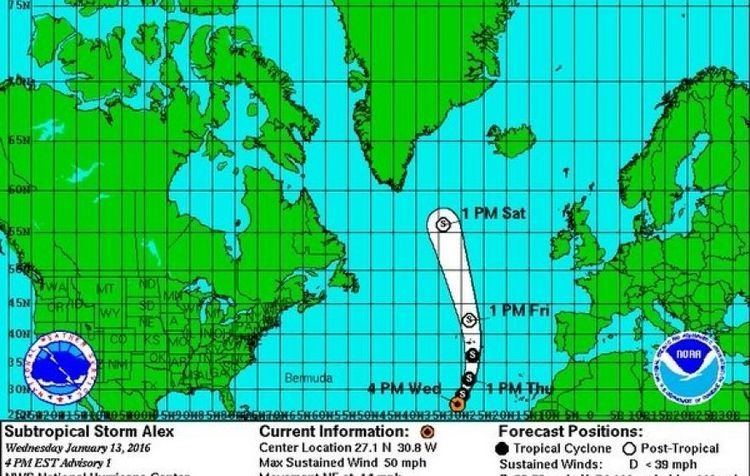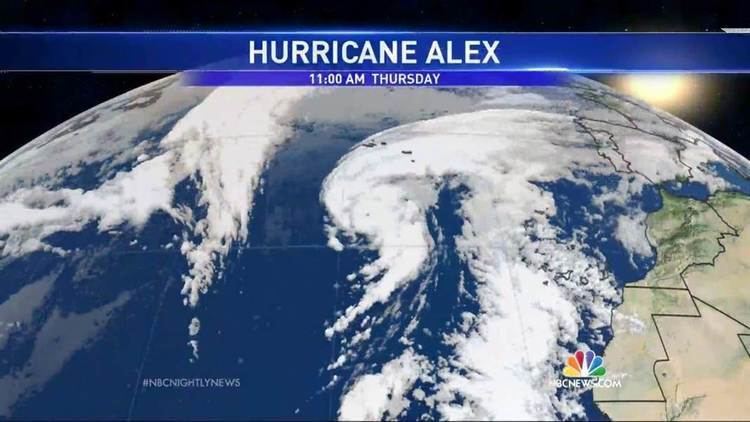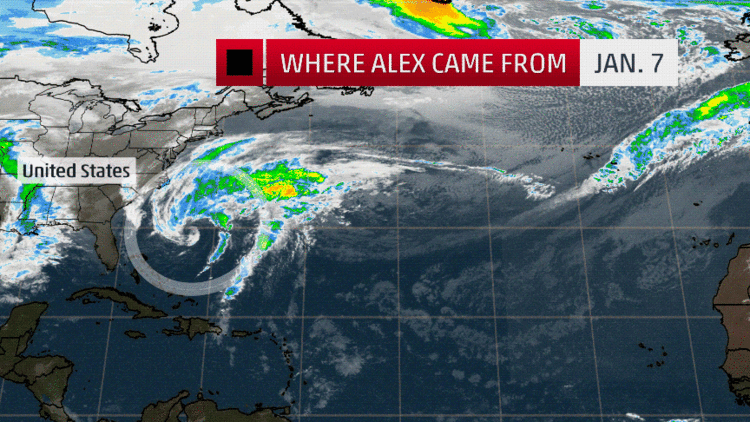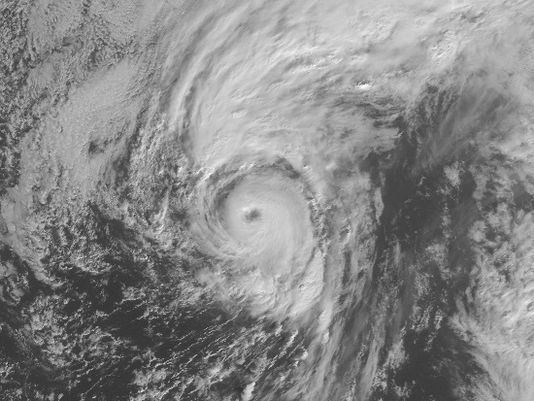Fatalities 1 indirect Areas affected BermudaAzores | Damage Minimal Highest winds 137 km/h | |
 | ||
Formed January 12, 2016 (January 12, 2016) Dissipated January 17, 2016 (January 17, 2016) Lowest pressure 981 mbar (hPa); 28.97 inHg Date 12 January 2016 – 17 January 2016 Similar Tropical Storm Bonnie, Hurricane Hermine, Hurricane Earl, Hurricane Matthew, Hurricane Nicole | ||
Hurricane Alex was the first Atlantic hurricane in January since Hurricane Alice in 1955, and the first to form in the month since 1938. Alex originated as an extratropical cyclone near the Bahamas on January 7, 2016. The system initially traveled northeast, passing Bermuda on January 8, before turning southeast. It subsequently deepened and acquired hurricane-force winds by January 10. Slight weakening took place thereafter, and the system eventually turned east and northeast as it acquired tropical characteristics. On January 12, it developed into a subtropical cyclone well south of the Azores, becoming the first tropical or subtropical system during January in the North Atlantic since an unnamed storm in 1978. As it turned north-northeast, Alex transitioned into a full-fledged tropical cyclone on January 14 and became a hurricane. The storm peaked as a Category 1 on the Saffir–Simpson hurricane wind scale with maximum sustained winds of 85 mph (140 km/h) and a barometric pressure of 981 mbar (hPa; 28.97 inHg). After weakening slightly, Alex made landfall on Terceira Island as a tropical storm the next day. Concurrently, Alex began transitioning back into an extratropical cyclone; it completed this cycle hours after moving away from the Azores. The system ultimately merged with another extratropical cyclone over the Labrador Sea on January 17.
Contents
The hurricane prompted the issuance of hurricane and tropical storm warnings for the Azores and the closure of schools and businesses. Alex ultimately brought gusty winds and heavy rain to the archipelago, causing generally minor damage. One person died from a heart attack when the inclement weather prevented a helicopter from transporting them to a hospital.

Background

As currently defined, the Atlantic hurricane season lasts from June 1 to November 30, the period in which tropical cyclones are most likely to develop across the basin. Occasionally, systems develop outside the season, most frequently in May or December. Activity in January is considered extremely rare, with only five other known instances since 1851: an unnamed hurricane in 1938, an unnamed tropical storm in 1951, Hurricane Alice in 1954–55, an unnamed storm in 1978, and Tropical Storm Zeta in 2005–06. Since Alice originated in December 1954, Alex is only the second hurricane to develop solely within January, after the 1938 storm. When Alex made landfall on Terceira as a strong tropical storm this marked only the second time that an Atlantic tropical cyclone has made landfall in January, with the other being Hurricane Alice of 1955 which made landfall on Saint Martin and Saba. In addition to forming well outside of hurricane season, Alex developed unusually far north and east, becoming only the second hurricane to form north of 30°N and east of 30°W.

Unrelated to Alex, Hurricane Pali developed over the Central Pacific in early January, and persisted through the formation of Alex. This marked the first known occurrence of simultaneous January tropical cyclones between the two basins.
Meteorological history

In early January 2016, a stationary front was draped across the western Caribbean; a non-tropical low developed along this boundary over northwestern Cuba by January 6. Moving northeast ahead of the subtropical jet stream, the system acquired a surface vortex the following day to the northeast of the Bahamas. Initial conditions, including strong wind shear, low sea surface temperatures, and dry air, inhibited formation of a tropical cyclone as the storm moved northeast toward Bermuda. The large system featured gale-force winds, with maximum sustained winds of 60–65 mph (95–100 km/h). On January 8, the system passed about 75 mi (120 km) north of Bermuda, bringing strong winds and heavy rain to the islands. On January 9, an anomalous blocking pattern prevented the cyclone from continuing along a seasonal northeasterly track. Instead, the storm turned east-southeast into a region slightly more favorable for subtropical development. Hurricane-force winds developed around the core of the cyclone on January 10 as it deepened to 979 mbar (hPa; 28.91 inHg), though convective activity near the center remained sparse. Separated from the jet stream, the cyclone dove south-southeast over the central Atlantic around a mid-latitude trough. Slight weakening took place on January 11.

Substantial structural changes took place on January 12: frontal boundaries separated from the core of the cyclone; convection developed atop the circulation; and it acquired a weak warm-core. All these factors, alongside the system being co-located with an upper-level low, indicated its transition into a subtropical cyclone by 18:00 UTC. Upon doing so, the system received the name Alex. Though relatively shallow, owing to the seasonally low level of the tropopause, convection was deemed deep enough for classification. At this time, the subtropical storm was situated 1,150 mi (1,850 km) west-southwest of the Canary Islands. The trough that previously enabled the sharp southward turn later steered Alex to the east-northeast and later north-northeast. Operationally, Alex was not classified as a subtropical storm until late on January 13.
An eye feature soon appeared within a complex of several banding features, marking intensification. The 20 mi (25 km) wide feature cleared out early on January 14 and was surrounded by a ring of −75 °F (−60 °C) cloud tops. As it moved away from the upper-level low it was previously situated under, Alex acquired a deeper warm core and upper-level outflow became established, indicating the system was becoming more tropical. Despite moving over 72 °F (22 °C) waters, Alex continued to deepen and transitioned into a full-fledged tropical cyclone by 06:00 UTC. The transition was enabled by colder-than-average upper-tropospheric temperatures which created greater instability than would otherwise be expected. Upon transitioning into a tropical cyclone, satellite intensity estimates—using the Dvorak technique—indicated Alex achieved hurricane strength. Soon thereafter, Alex achieved its peak intensity as a tropical cyclone with winds of 85 mph (140 km/h) and a barometric pressure of 981 mbar (hPa; 28.97 inHg); this made it a Category 1 on the Saffir–Simpson hurricane wind scale.
As Alex moved north toward the Azores, decreasing sea surface temperatures and increasing wind shear caused it to weaken late on January 14 and into January 15. The hurricane's eyewall opened up and its convective structure decayed, indicating the start of its transition back into an extratropical cyclone. Becoming increasingly tilted with height due to shear, Alex weakened to a tropical storm before making landfall over Terceira Island at 13:15 UTC with winds of 65 mph (100 km/h). Less than five hours later, the system completed its transition into an extratropical cyclone, with its circulation becoming more elongated and the radius of maximum winds expanding significantly. Furthermore, the overall structure became more "comma shaped", a feature of frontal systems. Turning northwest, the system deepened slightly to 978 mbar (hPa; 28.88 inHg) as it approached Greenland. Hurricane-force winds developed along the southeastern coast of Greenland due to interaction with the island's mountains, rather than the result of the storm intensifying. By 00:00 UTC on January 17, the remnants of Alex were absorbed by a larger extratropical low over the North Atlantic.
Bermuda
The precursor to Alex brought gale-force winds and heavy rain to Bermuda on January 8. Gusts to 60 mph (97 km/h) disrupted air travel, downed trees, and left sporadic power outages, while waves as high as 20 ft (6 m) necessitated small craft advisories for the islands. Ferry services to and from Cavello Bay, Dockyard, Belmont, Hodsdon’s Ferry, and Lower Ferry were suspended. During the three days in which the system impacted the territory, 1.33 in (34 mm) of rain fell at Bermuda International Airport.
Azores
Upon Alex's classification as a hurricane on January 14, the Azores Meteorological Service issued a hurricane warning for the islands of Faial, Pico, São Jorge, Graciosa, and Terceira. They also issued a tropical storm warning for São Miguel and Santa Maria. A red alert—the highest stage for meteorological warnings—was declared for central and eastern islands. Homeowners protected doors and windows with plywood and sandbags in anticipation of damaging winds and flooding. Officials closed schools and administrative buildings for the duration of the hurricane on January 15. SATA Air Açores cancelled 33 domestic and international flights for the morning of January 15, stranding more than 700 passengers. The hurricane and tropical storm warnings were discontinued after Alex's passage on January 15.
The first hurricane to impact the Azores since Hurricane Gordon in 2012, Alex brought heavy rain and gusty winds to the archipelago. It is the only known hurricane to track within 230 mi (370 km) of the Azores outside of August and September. Rainfall totals reached 4.04 in (103 mm) in Lagoa, São Miguel, and 3.71 in (94 mm) in Angra do Heroísmo, Terceira. Wind gusts exceeded 50 mph (80 km/h) on Santa Maria Island and peaked at 57 mph (92 km/h) in Ponta Delgada, São Miguel. The strong winds brought down trees, inflicted damage on some roofs, and triggered scattered power outages. Additionally, minor flooding was observed. Six homes in Ponta Delgada sustained flood damage and another had its roof destroyed. Landslides occurred across parts of the central islands, though they caused only limited damage. The overall effects of the storm were less than initially feared, possibly due to the maximum winds being located far from the center as Alex underwent extratropical transition. The hurricane indirectly led to one death—the person suffered a heart attack unrelated to the storm—when an Island Health Unit helicopter was unable to take off due to turbulent conditions.
